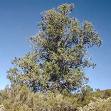Parry Pinyon Tree Information
Images of Parry Pinyon:






Parry Pinyon grows in the following 3 states and provinces:
California, Colorado, MaineInformation about Parry Pinyon:
The Pinus Quadrifolia is commonly known as the Four-needled Pinyon, Nut Pine as well as Parry Pinyon.
The currently accepted scientific name of Parry pinyon is Pinus quadrifolia Parl. . It is a member of the subgenus Haploxylon, subsection Cembroides . Lanner reduced Parry pinyon to hybrid status, (P. x quadrifolia Parl.), based upon studies of needle number, resin canal number, twig hairiness, and stomate position. He concluded that Parry pinyon is the result of hybridization between singleleaf pinyon (Pinus monophylla) and a heretofore unrecognized 5-needle pinyon now named Sierra Juarez pinyon (Pinus juarezensis). There are divergent opinions among botanists and taxonomists regarding these conclusions. Perry recognizes Parry pinyon as a separate species pending further studies. This paper will follow Perry's taxonomy. Parry pinyon hybridizes with P. monophylla and P. juarzensis. Lanner also suggests that Parry pinyon crosses with P. edulis and P. cembroides. There are no recognized varieties, subspecies, or forms of Parry pinyon. Parry pinyon is the most widespread coniferous tree in northern Baja California . It is mainly a Mexican species, growing in the Sierra de Juarez and Sierra San Pedro Martir. In the United States, Parry pinyon occurs in California. Several stands of Parry pinyon grow in southeastern San Diego County, and in the southwest corner of Imperial County, close to the Mexican border. A small population of Parry pinyon grows in south-central Riverside County, 30 miles (50 km) from the main distribution . Ranges of singleleaf pinyon and Parry pinyon overlap in southwestern California and northern Baja California . Parry pinyon is a dominant member of the pinyon-juniper woodland of southern California and northern Baja California. California juniper (Juniperus californica) commonly codominates with Parry pinyon . In the mountains of northern Baja California, Parry pinyon is associated with pine-oak (Pinus-Quercus spp.) woodlands and typical California chaparral . On the western flank of the interior Sierra de Juarez, Parry pinyon forms scattered groves within relatively dense chaparral of chamise (Adenostoma fasciculatum) and red shank (A. sparsifolium). Along the crest and eastern rim of the Sierra de Juarez it forms continuous forests with desert chaparral species such as peninsular manzanita (Arctostaphylos peninsularis) . A classifications listing Parry pinyon as a dominant species is: Woodland classification: the pinyon-juniper formation . Common plant associates not previously mentioned include Coulter pine (Pinus coulteri), Jeffrey pine (P. jeffreyi), and interior live oak (Q. wislizeni) .Some of the information provided here is attributed to:Esser, Lora L. 1993. Pinus quadrifolia. In: Fire Effects Information System, [Online]. U.S. Department of Agriculture, Forest Service, Rocky Mountain Research Station, Fire Sciences Laboratory (Producer). , available at the USDA Fire Effects Information System (FEIS) website